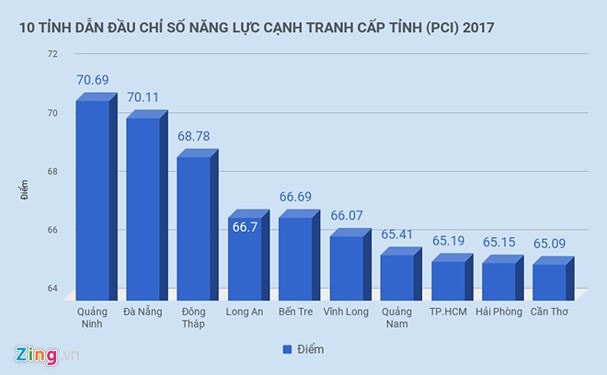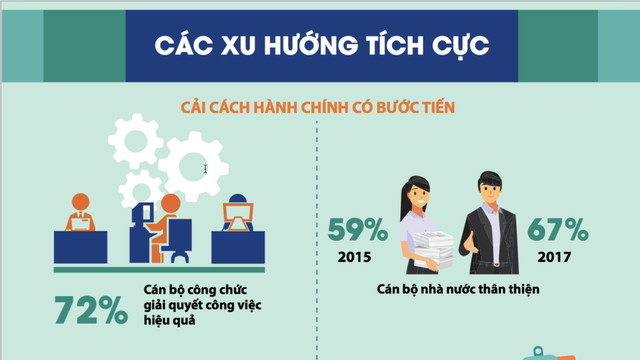What does the PCI index say?
(Baonghean.vn) - Conducted for the 13th consecutive year, the PCI 2017 report is based on feedback from more than 10,000 domestic private enterprises and nearly 1,800 foreign-invested enterprises in Vietnam... In the PCI 2017 rankings, Nghe An is ranked 21st, leading the North Central region (up 4 places compared to 2016) with a score of 63.25 on a 100-point scale.

Nghe An PCI index increased 4 places, ranked 21st in the country
(Baonghean.vn) - The above information was announced by comrade Nguyen Xuan Duong - Deputy Secretary of the Provincial Party Committee, Chairman of the Provincial People's Committee on the morning of March 22 at the online conference of the first quarter of 2018.
Over a long journey, PCI has become the voice representing the needs, hopes and aspirations of the Vietnamese private business community, directly and strongly conveying this voice to policy makers at both central and local levels.
What is PCI?
 |
PCI is an abbreviation of three English words: Provincial Competitiveness Index, translated into Vietnamese as "Provincial Competitiveness Index" - an index to evaluate and rank the governments of provinces and cities in Vietnam on the quality of economic management and building a favorable business environment for the development of private enterprises. This is a joint research project between the Vietnam Chamber of Commerce and Industry and the Vietnam Competitiveness Initiative project (a project funded by the United States Agency for International Development - USAID).
This index was first piloted in 2005 for 42 provinces and centrally-run cities and the second time from 2006 onwards, all provinces and cities in Vietnam were included in the ranking, and the component indexes were also enhanced.
Purpose of building PCI index
 |
The PCI index is not intended for purely scientific research or to praise or criticize provinces with high or low PCI scores. Instead, the PCI index seeks to understand and explain why some provinces and cities outperform others in terms of private sector development, job creation and economic growth, thereby providing useful information for provincial and city leaders to identify areas and ways to implement economic management reforms most effectively.
Unit implementing and publishing PCI index
The PCI Index is currently conducted by the Vietnam Chamber of Commerce and Industry (VCCI) with the support of the United States Agency for International Development (USAID). The PCI Index is jointly conducted by a group of domestic and foreign experts from VCCI.
Who participates in PCI assessment?
PCI is built from the perceptions and assessments of private sector enterprises operating in localities. State-owned enterprises, foreign-invested enterprises or investors are not included in the PCI survey.
PCI construction method
 |
To build the PCI, VCCI conducts a survey of enterprises in provinces and cities using a clustered random sampling method. Each year, approximately 10,000 private enterprises respond to the PCI survey. To build this index, in addition to survey data, the VCCI PCI research team also uses other information published by ministries and branches...
First published in 2005, PCI had 8 component indicators; In 2009, the PCI methodology was adjusted to 9 component indicators, including: 1) Low market entry costs; 2) Enterprises have easy access to land and stable business premises; 3) Open and transparent business environment, enterprises have equal access to information needed for business and necessary legal documents; 4) Minimal informal costs; 5) Time enterprises have to spend on administrative procedures and inspections is limited; 6) Proactive and pioneering provincial leaders; 7) Business support services, provided by the public and private sectors; 8) Good labor training policies; and 9) Legal and judicial systems to resolve disputes fairly and effectively.
What does PCI mean for local business?
 |
By standardizing scores around economic governance practices, the PCI encourages provincial governments to improve the quality of governance. And by eliminating the influence of fundamental factors that contribute to economic growth in a province, such as geography, infrastructure, market size, and human capital, the PCI helps identify and target good economic governance practices that can be achieved at the provincial level.
PCI is built on the basis of business assessments, so this index reflects objectively and honestly the investment and business environment of the locality. PCI reflects the economic management status of provincial governments, strengths and weaknesses, as well as determining which governments have good economic management quality and businesses are satisfied. From there, provincial governments will recognize what weaknesses in their business environment need to be overcome to meet the requirements of businesses.
Therefore, PCI is considered an important "voice" of private enterprises on the local business environment, a reliable reference information channel on investment locations, and an important reform driving force for the provincial business environment./.
